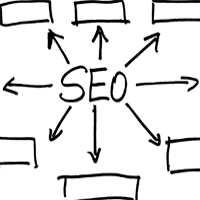Core Principles of SEO

Attracting the right site visitors is still an extremely important barometer for business success. With 54 percent of consumers citing organic search as the way they have typically found the sites they visit, your efforts in search engine optimization (SEO) are extremely important.
SEO success is not an overnight phenomenon. You need to dedicate time and patience to succeed. It is critical to stay on top of the latest changes in Google algorithms and develop a strategy that meets your specific objectives. Although a big part of it, this goes beyond simple keyword analysis and takes into account the fit within your overall Web presence.
A strong SEO plan includes a variety of key areas including a strategy with agreed-upon goals, budget, and tactics; demonstrated keyword research that analyzes volume, competition, and relevance; website optimization that adheres to SEO best practices; successful execution of content marketing, social media, directory listings, etc.; and the ability to monitor and evaluate website rankings and visitor analytics.
The benefits of a well-executed SEO strategy include higher website visibility ranking in search engines and more organic traffic to your website. Strong SEO also gives organizations qualified website visitors who go to your website based on relevant data, as well as inherent credibility in the digital universe.
Let's deep-dive into SEO's core principles and how to rank higher and drive more traffic.
Relevant High-Quality Content
Relevant and high-quality content is crucial for any website looking to improve its search engine rankings. High-quality content provides value to the reader, answers their questions, and helps them solve problems. It is well-researched, informative, and easy to read, with a clear and concise structure.
One important aspect of creating good quality content is conducting thorough keyword research to identify the keywords and phrases people use to search for content related to your business. This can help ensure that your content is optimized with the right keywords and phrases, making it more likely to appear in search engine results pages (SERPs) when people search for those terms.
According to a study by HubSpot, companies that publish 16 or more blog posts per month generate 3.5 times more traffic and 4.5 times more leads than companies that publish zero to four monthly blog posts. This highlights the importance of regularly creating high-quality content to attract and retain visitors.
Moz's Beginner's Guide to SEO is a good example of high-quality content. This guide provides comprehensive, well-researched information on the basics of SEO, and is frequently updated to ensure that it remains relevant and informative.
In contrast, poor quality, thin content provides little or no value to the reader. It may be poorly written, filled with errors, or lack depth and substance. It may also be irrelevant or poorly targeted, making it difficult for readers to find and engage with. Poor quality content can harm your website's rankings, as search engines strive to provide the best possible results for their users.
Keyword Research
Keyword research identifies the search terms that your target audience uses to find content related to your business. Good keyword research involves understanding the search intent behind each keyword and targeting keywords with high search volume and low competition.
According to a study by Ahrefs, long-tail keywords (more specific and longer in length) account for 92.42% of all keywords. This highlights the importance of targeting long-tail keywords relevant to your business and audience, as they can be easier to rank for and attract more qualified traffic.
Keyword research is a critical aspect of any successful SEO strategy. By understanding the terms and phrases users employ to find information, products, or services, you can optimize your website's content to match their intent. Additionally, conducting competitor analysis allows you to identify gaps in their keyword targeting and content, presenting valuable opportunities for your own SEO efforts. This article will explore how to perform effective keyword research, highlight some of the best tools available, and explain how to audit competitors to uncover keyword and content gaps.
Keyword Research Process
Define Your Goals: Determine the objectives of your keyword research, such as increasing organic traffic, targeting specific demographics, or expanding into new markets.
Brainstorm Seed Keywords: Begin with a brainstorming session to generate a list of seed keywords relevant to your business or industry. Consider the terms users might search for when seeking information about your products or services.
Expand with Keyword Research Tools: Utilize keyword research tools to expand your initial list of seed keywords. These tools provide data on search volume, competition, and related keywords. Some popular keyword research tools include:
- Google Keyword Planner: Offers insights into search volume, competition, and keyword suggestions based on seed keywords or landing pages.
- SEMrush: Provides a comprehensive suite of SEO tools, including keyword research, competitor analysis, and organic traffic insights.
- Ahrefs: Offers a robust keyword explorer tool, allowing you to analyze keyword metrics, search volumes, and competitor data.
- Moz Keyword Explorer: Provides keyword suggestions, search volume, and difficulty scores, along with competitive analysis features.
- Ubersuggest: Offers keyword suggestions, search volume data, and keyword difficulty analysis.
Analyze and Refine: Evaluate the keyword metrics from your research tools and narrow down your list based on relevance, search volume, competition, and user intent. Focus on keywords that align with your goals and have a balance of search volume and competition.
Group and Categorize Keywords: Organize your keywords into groups or categories based on themes, intent, or target pages. This helps with content planning and website structure.
Competitor Analysis and Identifying Keyword/Content Gaps
Identify Competitors: Identify the key competitors in your niche or industry. These are websites or businesses targeting similar keywords and audience segments.
Analyze Competitor Websites: Explore competitor websites to understand their content strategy, keyword targeting, and user experience. Pay attention to their homepage, landing pages, blog sections, and product/service descriptions.
Identify Targeted Keywords: Use keyword research tools or SEO software to determine the keywords your competitors are targeting. Look for common keywords across their website and assess their search volume and competitiveness.
Discover Keyword and Content Gaps: Compare your keyword list with your competitors. Look for keywords that your competitors are targeting, but you have not yet incorporated into your strategy. These gaps represent opportunities for you to capture additional organic traffic.
Keywords are also important to shoppers at different stages of the buyer's journey. By understanding the buyer's intent at each stage, you can create content that aligns with their needs and guides them through the purchasing process. Here are the types of keywords commonly associated with each stage of the buyer's journey, along with examples:
Awareness Stage Keywords
Keywords: Informative, problem-focused, and educational keywords.
Intent: Users are seeking information and solutions to their problems.
Examples:
"How to lose weight quickly"
"Causes of back pain"
"Benefits of content marketing"
Consideration Stage Keywords
Keywords: Comparison, research-oriented, and product category keywords.
Intent: Users evaluate different options and compare alternatives.
Examples:
- "Best smartphones under $500"
- "Comparison of DSLR cameras"
- "Reviews of top email marketing software"
Evaluation Stage Keywords
Keywords: Specific brand or product keywords, reviews, and features.
Intent: Users narrow their options and seek detailed information about specific products or services.
Examples:
- "iPhone 12 Pro vs. Samsung Galaxy S21"
- "Review of XYZ laptop"
- "Features of Honda Civic 2023"
Purchase Stage Keywords
Keywords: Transactional keywords, discounts, and product names with purchase intent.
Intent: Users are ready to make a purchase decision and are actively looking for the best deal.
Examples:
- "Buy iPhone 12 Pro online"
- "Discount code for XYZ product"
- "Best price for Canon EOS R6"
Post-Purchase Stage Keywords
Keywords: Support, tutorials, and customer service-related keywords.
Intent: Users are seeking post-purchase assistance, troubleshooting, or information about product usage.
Examples:
- "How to set up XYZ software"
- "Troubleshooting common printer issues"
- "Customer support for XYZ product"
On-Page Optimization
On-page optimization involves optimizing your website's structure, meta tags, headlines, and URLs for search engines. This helps search engines understand the content on your website and index it more effectively. Good on-page optimization involves using relevant keywords in your title tags, meta descriptions, and headings and optimizing your website's structure and URL structure for search engines.
According to a study by Backlinko, having a meta description that includes the target keyword can improve click-through rates (CTR) by 5.8%. This highlights the importance of optimizing meta descriptions with relevant keywords to improve visibility and attract more clicks.
A good example of on-page optimization is the website for an online retailer that sells organic skincare products. The website uses relevant keywords in its title tags, meta descriptions, and headings, and includes product descriptions that are optimized with relevant keywords and phrases.
In contrast, poor on-page optimization can make it difficult for search engines to understand the content on your website, resulting in poor search engine rankings and poor visibility. For example, a website that sells fitness equipment may have poorly written product descriptions that do not include relevant keywords, making it difficult for search engines to understand what the page is about and how to index it properly.
Technical SEO
Technical SEO involves optimizing your website's technical aspects, such as page load speed, mobile-friendliness, and secure HTTPS connection. This helps search engines crawl and index your website more effectively, and improves user experience. Good technical SEO involves ensuring that your website is fast, mobile-friendly, has a secure HTTPS connection, and implementing structured data markup to help search engines understand your content.
According to a study by Google, 53% of mobile users abandon sites that take longer than three seconds to load. This highlights the importance of having a fast website that loads quickly on desktop and mobile devices.
Some Additional Elements of Technical SEO Include
Technical SEO involves optimizing the technical aspects of a website to improve its visibility, crawlability, and indexability by search engines. Here are the key elements of technical SEO:
Website Speed and Performance
- Fast-loading pages: Optimize images, enable caching, minify code, and leverage content delivery networks (CDNs) to improve page load times.
- Mobile optimization: Ensure your website is responsive and performs well on mobile devices.
- Reduce server response time: Optimize server configurations and hosting, utilize caching mechanisms, and minimize redirects.
Website Crawlability
- Robots.txt: Create and optimize the robots.txt file to control search engine crawling and ensure that important pages are accessible.
- XML sitemap: Generate an XML sitemap and submit it to search engines to help them discover and crawl your website's pages.
- URL structure: Use descriptive, user-friendly URLs and avoid dynamic parameters or excessive subfolders.
Indexing
- Canonical tags: Implement canonical tags to address duplicate content issues and consolidate ranking signals to the preferred version of a page.
- Meta tags: Optimize meta tags, including title tags and meta descriptions, to accurately represent the content of each page.
- Structured data: Implement structured data markup, such as schema.org, to provide search engines with additional context about your website's content.
Site Architecture and Navigation
- User-friendly navigation: Ensure that your website has a clear, intuitive navigation structure that allows both users and search engines to easily find and access pages.
- Internal linking: Use internal links to establish a hierarchical structure, distribute authority, and facilitate the discovery and indexing of important pages.
HTTPS and Security
- SSL certificate: Implement HTTPS encryption by obtaining and installing an SSL certificate to ensure secure communication between your website and users.
- Secure protocols: Configure your website to use secure protocols, such as TLS, to protect user data and enhance trust.
Mobile Friendliness
- Responsive design: Optimize your website to provide a seamless and user-friendly experience across different screen sizes and devices.
- Mobile usability: Ensure that buttons, links, and interactive elements are easily tappable and visible on mobile devices.
Website Accessibility
- The Alt tag is probably the most important image-optimization factor. Alt stands for alternate and the text in the alt tag is displayed in place of the image if the image cannot be shown or is taking too long to load.
- Proper HTML markup: Structure your website's HTML code following best practices to enhance accessibility and facilitate screen reader interpretation.
Technical Audit and Monitoring
- Regular audits: Conduct technical audits to identify and fix issues that may negatively impact SEO performance.
- Monitoring and maintenance: Continuously monitor website health, crawl errors, broken links, and other technical issues using tools like Google Search Console and third-party SEO software.
Backlinks
Backlinks are links from other websites to your website and are important in improving your website's authority and search engine rankings. Good backlinks are from reputable websites relevant to your content and obtained through natural, organic means. They also provide value to the reader, such as additional information or resources.
Backlinks are crucial for several reasons
- Search Engine Ranking Factor: Search engines view backlinks as votes of confidence from other websites. Websites with higher-quality backlinks tend to rank higher in search results.
- Authority and Trust: Backlinks from reputable and authoritative websites signal to search engines that your website is trustworthy and valuable, boosting your online credibility.
- Referral Traffic: Backlinks not only improve SEO but also drive referral traffic. When users click on a backlink, they are directed to your website, expanding your reach and potential customer base.
- Discoverability: Backlinks can help search engines discover and index your website's pages more effectively, ensuring your content reaches a wider audience.
Different Strategies and Tactics for Acquiring High-Quality Backlinks
Create Valuable Content
- Develop high-quality, informative, and engaging content that naturally attracts backlinks.
- Craft comprehensive guides, research papers, how-to articles, and unique resources that offer value to your target audience.
Outreach Link Building and Relationship Building
- Contact relevant websites and influencers in your industry, offering guest posts or collaborative content opportunities.
- Build relationships through networking, social media engagement, and attending industry events to establish connections for potential backlink opportunities.
Broken Link Building
- Identify broken links on authoritative websites that are relevant to your content.
- Reach out to the website owner or webmaster, notifying them about the broken link and suggesting your content as a replacement.
Skyscraper Technique
- Identify popular and link-worthy content in your industry.
- Create superior, more comprehensive, and up-to-date content on the same topic.
- Reach out to websites that linked to the original content, showcasing your improved version and requesting a link.
Guest Blogging
- Identify reputable blogs and websites accepting guest posts in your niche.
- Write high-quality guest posts that offer value to their audience, including a backlink to your website in the author bio or within the content.
Content Promotion and Outreach
- Share your content through social media, email newsletters, and online communities.
- Reach out to influencers, bloggers, and industry publications, informing them about your valuable content to encourage link sharing.
Participate in Industry Directories and Associations
- Submit your website to relevant industry directories and associations that offer backlink opportunities.
- Ensure the directories and associations are reputable and trusted within your industry.
Monitor Competitor Backlinks
Analyze backlinks pointing to your competitors' websites using SEO tools.
Identify potential backlink sources and outreach opportunities that can benefit your website.
According to a study by Moz, high-quality backlinks from authoritative websites can significantly improve search engine rankings. In fact, their study found that websites with a high number of high-quality backlinks tend to rank higher in search engine results pages (SERPs) than websites with a low number of backlinks.
A good example of high-quality backlinks is a website that offers financial advice and is featured in a reputable financial publication. The publication includes a link to the website as a resource for readers, providing valuable backlink and driving relevant traffic.
In contrast, poor backlinks are from low-quality, spammy websites and are obtained through black hat SEO tactics, such as buying links or using link farms. Poor backlinks can harm your search engine rankings and reputation, while good backlinks can improve your search engine rankings and authority.
Backlinks are fundamental to a successful SEO strategy. They enhance the website authority, improve search engine rankings, drive referral traffic, and establish online credibility. You can acquire high-quality backlinks that strengthen your website's SEO performance by implementing strategies and tactics like creating valuable content, outreach, broken link building, and guest blogging.
Social Media Presence
Social media can help promote your content and increase your website's visibility, leading to more backlinks and traffic. Good social media presence involves using social media platforms to share your content, engage with your audience, and build relationships with influencers and thought leaders in your industry.
According to a study by Social Media Examiner, 92% of marketers indicated that social media was important for their business, with 80% indicating that social media has increased their website traffic. This highlights the importance of having a strong social media presence to drive traffic to your website.
While not a direct ranking factor, social media plays a role in search engine optimization (SEO) and can impact your website's visibility in search engine results pages (SERPs). Here's how social media can help with SEO:
- Increased Website Traffic: Sharing your website content on social media can drive more traffic. When your content is engaging and valuable, social media users may click on your links, visit your website, and explore further. Increased website traffic can positively impact your search rankings.
- Social Signals: Social media activity, such as likes, shares, and comments, can serve as social signals to search engines. While the direct influence of social signals on SEO rankings is debated, strong social engagement can indirectly impact SEO. When your content is widely shared on social media, it can attract more backlinks from authoritative websites, which are crucial factors in SEO.
- Brand Awareness and Authority: Social media platforms provide an excellent opportunity to build your brand's online presence and establish authority in your industry. Consistently sharing valuable content, engaging with your audience, and participating in relevant discussions can enhance your brand visibility. When people recognize and trust your brand, they are more likely to search for it by name, increasing branded searches that positively affect SEO.
- Improved Link-Building Opportunities: Social media can be a valuable tool for link-building. Sharing your content on social media increases the chances of others discovering and linking to it from their websites, blogs, or online publications. Building high-quality backlinks from reputable sources is a key aspect of SEO and social media can facilitate this process by amplifying your content's reach.
- Social Media Profiles in Search Results: Search engines often display social media profiles in their results for branded searches. Active and optimized social media profiles can help occupy more real estate on the search results page, providing additional visibility and opportunities to attract clicks.
- Enhanced Local SEO: Social media platforms offer location-based features that can benefit local businesses. By optimizing your social media profiles with accurate business information, geotags, and location-based keywords, you can improve your chances of appearing in local search results, especially in platforms like Google My Business and Facebook Pages.
Local SEO
Local SEO is optimizing your website and online presence for local search results. This is important for businesses with a physical location or providing services to customers in a specific geographic area. Good local SEO involves optimizing your website for local keywords, building local citations, and obtaining positive online reviews.
According to a study by Google, 46% of all searches have a local intent, meaning that people are searching for products or services in their local area. This highlights the importance of optimizing your website for local search to attract local customers.
Why Local SEO Matters
- Increased Local Visibility: Local SEO ensures that your business appears prominently in local search results, making it easier for potential customers to find you.
- Higher Conversion Rates: Local searches often indicate strong purchase intent. By targeting local keywords, you can attract highly motivated customers who are more likely to convert into leads or sales.
- Competitive Edge: Optimizing your online presence for local searches allows you to stand out from the competition, especially in your specific geographic area.
- Mobile-Focused: With the rise in mobile device usage, local searches have witnessed significant growth. Local SEO ensures that your business is visible to mobile users searching for nearby solutions.
Local SEO Strategies and Tactics
Optimize Your Google My Business (GMB) Listing
- Claim and verify your GMB listing, ensuring accurate business information, such as name, address, phone number (NAP), and website URL.
- Select relevant categories and add a compelling business description. Encourage customers to leave reviews, respond promptly to reviews, and engage with customer queries.
Consistent NAP Information
- Ensure your NAP information is consistent across your website, GMB listing, and other online directories.
- Use schema markup to provide search engines with structured data about your business's location.
Localized Keyword Research
- Identify location-specific keywords relevant to your business and incorporate them naturally into your website's content, meta tags, headings, and image alt tags.
- Focus on long-tail keywords that include specific location modifiers.
Online Directories and Citations
- List your business in reputable online directories, such as Yelp, Yellow Pages, and industry-specific directories.
- Ensure accurate and consistent NAP information across all directories.
Location-Specific Landing Pages
- Create dedicated landing pages for each location or target area you serve.
- Optimize these pages with relevant keywords, unique content, and localized information.
Local Content Marketing
- Develop content that caters to the interests and needs of your local audience.
- Create blog posts, articles, or videos targeting local events, news, and community initiatives.
Online Reviews and Reputation Management
- Encourage satisfied customers to leave positive reviews on platforms like Google, Yelp, and industry-specific review sites.
- Respond promptly and professionally to all customer reviews, including negative ones, to showcase your commitment to customer satisfaction.
Content Marketing
Content marketing involves creating and sharing valuable, informative, and relevant content to attract and engage a target audience. This can include blog posts, videos, infographics, whitepapers, and more. Good content marketing involves creating high-quality content that provides value to your audience, using relevant keywords and optimizing content for search engines.
According to a study by Content Marketing Institute, 91% of B2B marketers use content marketing to reach customers. This highlights the importance of creating valuable content to attract and engage your target audience.
Effective Content Marketing Strategies and Tactics
-
-
- Define Your Target Audience:
- Understand your target audience's demographics, interests, pain points, and motivations.
- Develop buyer personas to create content that resonates with your audience.
- Develop a Content Strategy:
- Set clear goals and objectives for your content marketing efforts.
- Plan a content calendar outlining topics, formats, and distribution channels.
- Align your content strategy with your brand's unique voice and values.
- High-Quality and Valuable Content:
- Create content that provides value, educates, entertains, or solves problems for your target audience.
- Focus on originality, relevance, and accuracy in your content.
- Incorporate storytelling elements to captivate and engage your audience.
- Diversify Content Formats:
- Experiment with various content formats, such as blog posts, videos, infographics, podcasts, and interactive content.
- Adapt your content format to cater to different learning preferences and platforms.
- Content Promotion and Distribution:
- Leverage social media platforms, email marketing, influencer partnerships, and guest blogging to amplify your content reach.
- Engage with your audience through discussions, comments, and shares.
- Utilize paid advertising or native advertising to boost visibility.
- Define Your Target Audience:
-
Content Gap Analysis
-
-
- Identify Competitor Content:
- Analyze your competitors' content to understand their production and focus areas.
- Identify gaps in their content that you can fill with your unique perspectives or additional information.
- Identify Audience Needs and Interests:
- Conduct surveys, interviews, or social listening to gather insights about your target audience's content preferences.
- Identify topics or areas where your audience is seeking more information or solutions.
- Keyword Research:
- Use keyword research tools to identify relevant keywords and search phrases that align with your business and audience needs.
- Discover content gaps by finding keywords with high search volume but low competition.
- Identify Competitor Content:
-
Creating Consumable and SEO-Optimized Content
-
-
- Write Engaging Headlines and Meta Tags:
- Craft attention-grabbing headlines and meta tags that accurately represent the content and incorporate relevant keywords.
- Structure Content for Readability:
- To enhance readability, use headings, subheadings, bullet points, and short paragraphs.
- Incorporate visuals, such as images, infographics, or videos, to break up text and improve user experience.
- Incorporate Relevant Keywords:
- Naturally incorporate target keywords throughout the content, including in headings, subheadings, and within the body.
- Avoid keyword stuffing and focus on creating valuable, comprehensive content.
- Optimize for Mobile:
- Ensure your content is mobile-responsive and loads quickly on all devices.
- Consider mobile search intent and user experience when designing and formatting content.
- Link Building and Internal Linking:
- Include relevant and authoritative external links to support your content and provide additional resources. Incorporate internal links to guide users to related content within your website.
- Write Engaging Headlines and Meta Tags:
-
Mastering content marketing requires a thoughtful strategy, valuable content creation, and optimization for search engines. By understanding your audience, conducting content gap analysis, and implementing SEO optimization techniques, you can create consumable content that resonates with your target audience and boosts your visibility in
User Experience
User experience (UX) plays a crucial role in SEO. Search engines like Google prioritize delivering the best possible results to their users, and a positive user experience is a key factor in determining the quality of a website. Here's how user experience impacts SEO:
- Website Engagement: Search engines analyze various engagement metrics to determine the relevance and quality of a website. Factors such as bounce rate, time spent on page, and click-through rates contribute to these metrics. A positive user experience encourages visitors to stay longer on your site, interact with your content, and explore multiple pages. This engagement sends positive signals to search engines, indicating that your website provides valuable information and satisfies user intent.
- Page Load Speed: Slow-loading websites frustrate users and can lead to higher bounce rates. Search engines recognize this and consider page load speed as an important ranking factor. Optimizing your website's performance, such as reducing server response time, optimizing images, and minifying code, enhances user experience and positively impacts SEO.
- Mobile-Friendliness: With the majority of searches now happening on mobile devices, having a mobile-friendly website is essential. Search engines prioritize mobile-friendly websites in mobile search results. A responsive design that adapts to different screen sizes, easy navigation, and readable content without the need for excessive zooming or horizontal scrolling are all critical aspects of providing a positive user experience.
- Clear Site Structure and Navigation: A well-organized website structure and intuitive navigation improve user experience and help visitors find the information they need efficiently. Search engines analyze the structure of your website to understand its hierarchy and determine the relevance of different pages. User-friendly navigation enhances crawlability and indexability, making it easier for search engines to discover and rank your content.
- Relevant and Engaging Content: User experience is closely tied to the quality and relevance of your content. Creating high-quality, informative, and engaging content tailored to your target audience's needs enhances user experience. When users find your content valuable, they are more likely to stay on your site, share it, and return in the future. These positive user signals contribute to improved SEO performance.
- Mobile-First Indexing: Google has shifted to a mobile-first indexing approach, where the mobile version of a website is given priority over the desktop version. This change further highlights the significance of user experience on mobile devices. Websites that provide a seamless mobile experience are more likely to rank higher in search results.
- User Signals and Social Engagement: User signals, such as click-through rates (CTRs) and social engagement metrics (likes, shares, comments), are indirect indicators of user satisfaction and interest in your content. Higher CTRs and social engagement can lead to improved organic visibility, as search engines interpret these signals as a measure of quality and relevance.
Analytics and Reporting
Analytics and reporting are essential for understanding your SEO strategy's effectiveness and identifying improvement opportunities. Good analytics and reporting involve tracking key performance indicators (KPIs) such as organic traffic, search engine rankings and conversion rates, and using this data to make informed decisions about your SEO strategy.
According to a study by Google, businesses that use data-driven insights to make decisions are three times more likely to achieve significant improvements in decision-making and a 10% increase in profitability. This highlights the importance of using analytics and reporting to inform your SEO strategy.
A good example of analytics and reporting is a company that offers online courses. The company tracks its website's organic traffic, search engine rankings, and conversion rates, and uses this data to optimize its website's content, keywords, and user experience.
In contrast, poor analytics and reporting involve neglecting to track and analyze key performance indicators, resulting in a lack of understanding of the effectiveness of your SEO strategy. This can lead to missed opportunities for improvement and a lack of progress in achieving your SEO goals.
These 10 core principles are vital to SEO. From creating high-quality content to tracking key performance indicators, each aspect of SEO plays a crucial role in improving your website's visibility and search engine rankings. By focusing on these principles and implementing best practices, you can create an effective SEO strategy that drives traffic, improves user experience, and achieves your business goals.
What are factors that can prevent top ranking?
Your answer to the questions below should be "No" to have an effective SEO strategy.
- Did you copy other Web page content?
- Did you duplicate content?
- Do you use the same title and Meta tags for multiple pages?
- Do you use automated link building schemes?
- Do you buy or sell links?
- Do your backlinks come from spammy sites?
- Do you link to sites that don't deserve to be linked to?
About the Author







